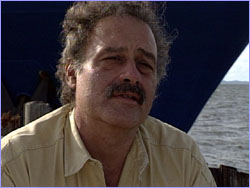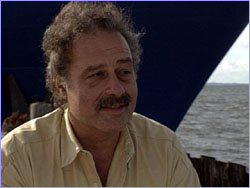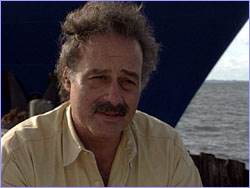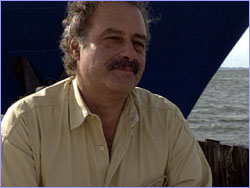
|
 |
 |
 Meet the Team:
Meet the Team:Dr. Edmond A. Mathez Dr. Edmond A. Mathez is Director of the Earth and Planetary Sciences Department at the American Museum of Natural History. He is also the principal scientist involved in the design of the museum's new Hall of the Planet Earth, which is slated to open in the summer of 1999. Ideally, a black smoker from this expedition will end up in that exhibition. NOVA: Why do you want to bring back a black smoker for the museum? Mathez: Well, to put it in context, the American Museum is an academic institution in the tradition of the large European natural history museums. Part of our responsibility is to make collections, for collections are the fabric of our science. We guard these collections for the scientific community, and we hold them in the public trust. And, of course, we want to exhibit some of them. That is our second important responsibility: to show what the natural world is like to the people that come to visit the museum. More specifically, black smokers are important icons of what has almost become a new science. In our upcoming Hall of Planet Earth, we ask the question, "What makes the Earth habitable?" Implicit in that question is that the boundaries of our fields are changing rapidly, especially between geology and biology. We no longer view the notion of the origin or evolution of life as questions you can reasonably talk about without also talking about the evolution of the Earth. The black smoker is iconic of that shift in thinking, because it represents a part of the world where organisms live on the chemical and thermal energy of the Earth, not on sunlight. And at the same time, we're investigating how these organisms influence precipitation of certain minerals. NOVA: Do you think it's important that the public have the opportunity to see real objects and not just models?  Mathez: As real scientists, we have to have real
objects to study, and we don't want to show fake objects, if
you will. Showing real objects also illustrates the
seriousness and passion we bring to our trade, which come
through in the care with which such objects are exhibited.
Some of the dioramas in the museum, for example, are exquisite
works of art, and that implicit care and dedication to detail
moves people, I think.
Mathez: As real scientists, we have to have real
objects to study, and we don't want to show fake objects, if
you will. Showing real objects also illustrates the
seriousness and passion we bring to our trade, which come
through in the care with which such objects are exhibited.
Some of the dioramas in the museum, for example, are exquisite
works of art, and that implicit care and dedication to detail
moves people, I think.Furthermore, this is a frontier that only a few scientists have had the opportunity to visit. Of course, we have photographs. But to see a photograph is not to see the real thing, to see it in all its beauty. It's the difference between seeing African mammals in a nature program and seeing them in the wild—or at least in our dioramas. NOVA: Would you consider deep-sea vents a final frontier? Mathez: They certainly represent one of the last frontiers on Earth. One of the reasons we're exploring this realm now is because we know enough about it to know that we know very little about it. It's a frontier whose time has come. I would say it is similar to that of the western United States at the time of the American Revolution, when people knew there were mountains and there was a Pacific Ocean. But they didn't know how high the mountains were or how far the Pacific Ocean was. They didn't know the best route, they didn't know who or what lived there, or what resources were there, or whether it was livable or not. NOVA: How does this expedition compare to others the museum has mounted?  Mathez: It is very much within our tradition of probing
the frontiers, of going places that other people haven't gone
before. It's very exciting to be able to go to a true frontier
and to bring the fruits of those expeditions back to the
museum. Comparatively speaking, this must be one of the most
ambitious expeditions the museum has ever mounted. It's not
only very expensive, but it's complicated. There's an enormous
amount of planning and equipment and people to get together.
Furthermore, it's risky. But I find that to be one of the fun
things about expeditions: you don't actually know if you're
going to get what you set out to get.
Mathez: It is very much within our tradition of probing
the frontiers, of going places that other people haven't gone
before. It's very exciting to be able to go to a true frontier
and to bring the fruits of those expeditions back to the
museum. Comparatively speaking, this must be one of the most
ambitious expeditions the museum has ever mounted. It's not
only very expensive, but it's complicated. There's an enormous
amount of planning and equipment and people to get together.
Furthermore, it's risky. But I find that to be one of the fun
things about expeditions: you don't actually know if you're
going to get what you set out to get.NOVA: Do you like the multidisciplinary nature of this expedition, with different scientists working together toward the same goal? Mathez: Personally, I always find it exciting to work with people in other disciplines, because each of us was taught different ways of approaching problems. I have been fortunate enough to work with physicists, for example, and I've always found that to be very stimulating. It's part of the wisdom one acquires in the sciences. And we're entering a period in our science when interdisciplinary work is becoming increasingly important. It wouldn't make any sense to study objects like black smokers just from the point of view of their biology or just from the point of view of their geology. NOVA: What big scientific questions might you and other researchers address with black smokers? Mathez: General questions concerning the origin, evolution, and diversity of life. These environments, in fact, could very well be models for how life exists on other planets. In addition, black smokers are ore deposits in the making, and they're iconic of very large-scale global processes. For instance, they may hold a record of hydrothermal circulation in the mid-ocean ridge from which they've been collected. NOVA: How does it feel to be involved in planning and designing the Hall of Planet Earth?  Mathez: I feel a certain sense of responsibility as the
person leading the team that is developing this exhibit to
bring really exciting and new things to the people that visit
the museum, and a black smoker is definitely exciting and new.
And I feel proud and honored to have the opportunity to show
off my science, even my field, by having something that
excites my colleagues and me and will allow us to tell a story
that very few people know or understand.
Mathez: I feel a certain sense of responsibility as the
person leading the team that is developing this exhibit to
bring really exciting and new things to the people that visit
the museum, and a black smoker is definitely exciting and new.
And I feel proud and honored to have the opportunity to show
off my science, even my field, by having something that
excites my colleagues and me and will allow us to tell a story
that very few people know or understand.NOVA: What do you hope a black smoker might do for people visiting the new hall? Mathez: Exhibits inspire people. They force the imagination. At least they do mine when I walk through the Hall of African Mammals, for example, and look at those beautiful dioramas. My imagination is inspired, though I'm not sure I know all the reasons for that. Perhaps one of them is because implicitly I see that there's so much effort and passion put into them. I would hope that the black smoker will inspire awe. Visitors will wonder at something that is not part of their particular reality: "My God, this is part of the Earth. Isn't that astonishing? Isn't that a wonderful thing?" Interviews: Delaney | Kelley | Mathez | Olson | Shepherd Birth of an Expedition | Mission Plan | Dispatches Through the Porthole | Meet the Team Meet ROPOS (JavaScript/Frames-capable browser required) Meet ROPOS (No Frames/JavaScript) The Mission | Life in the Abyss | The Last Frontier | Dispatches E-mail | Resources | Table of Contents | Abyss Home Editor's Picks | Previous Sites | Join Us/E-mail | TV/Web Schedule About NOVA | Teachers | Site Map | Shop | Jobs | Search | To print PBS Online | NOVA Online | WGBH © | Updated October 2000 |